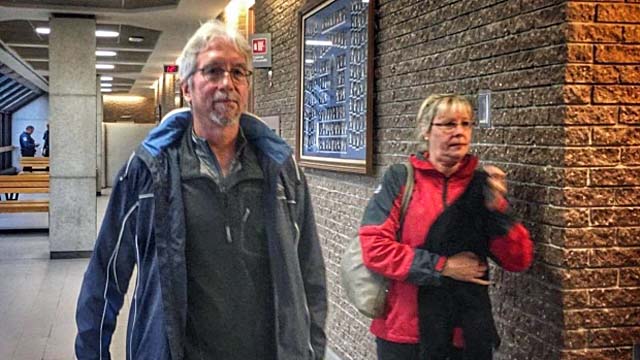
Sherbrooke Quebec - Two days after a runaway train derailed in Lake Megantic, exploding and killing 47 people, Transport Canada (TC) inspector Alain Richer found another train belonging to the Montreal Maine & Atlantic (MMA) railway parked in nearby Vachon hadn't been properly secured.
Richer, now retired, testified Monday at the trial of Thomas Harding 56, Jean Demaitre 53, and Richard Labrie 59.
According to Richer, when he and another TC employee went to inspect the 89 car train, they noticed it had been secured with only five handbrakes.
"They hadn't met the minimum required," Richer testified.
He said MMA's own internal regulations showed the train should have been secured with double that number of handbrakes.
To determine the minimum number of handbrakes, Richer testified, workers had to follow a simple calculation, outlined on a chart in the company's general instructions, Take 10 percent of the number of rails cars, then add two.
Based on that chart, the train parked in Vachon should have been secured with 10 handbrakes, Richer said.
When Richer noticed only five handbrakes had been applied, he contacted an MMA supervisor, who sent an employee to the site.
That employee, Randy Stahl, performed a brake efficiency test on the train as Richer watched.
This essentially means engaging the locomotive's throttle at its lowest power setting to see if it would move or stay put.
The train didn't move, passing the test.
Just the same, Stahl put on an additional seven handbrakes, bringing the number to 12.
However, Michael Horan, MMA's assistant director of operations, later added another three handbrakes, bringing the total to 15, the trial has heard.
Richer also testified that MMA employees had not inspected the tanker cars involved in the Lake Megantic disaster.
He said according to the rules and regulations, the cars didn't warrant an inspection, as the train had already been certified by Canadian Pacific Rail employees at the Cote Saint-Luc yard before it left for Farnham.
Penalty Brake Failed to Kick in
Richer also testified on tests he and a colleague performed on locomotive 5017, the lead locomotive involved in the 6 Jul 2013 derailment, to determine how long it took for the air brakes to lose their efficiency on the night the train derailed.
The court heard earlier in the trial that the locomotive had been shut down by firefighters who doused a fire on board about an hour before it rolled, unmanned, down the track towards Lake Megantic.
Richer said the test was to determine how much air was left inside the air conduit when the train broke away.
Harding's lawyer asked the witness if the test was also to determine why the penalty brake, a type of backup defence, mean to prevent runaway trains, didn't kick in.
"We already knew there was no emergency application. Indeed, we wanted to know why," said Richer.
Richer said the test did identify the cause.
The explanation of that cause is being left to another Crown witness, Stephen Callaghan, a rail expert who is to testify later in the trial.
Richer resumes his testimony before Superior Court Justice Gaetan Dumas and a 14 member jury at the Sherbrooke courthouse Tuesday.
Claude Rivest.
of the Canadian Copyright Modernization Act.



